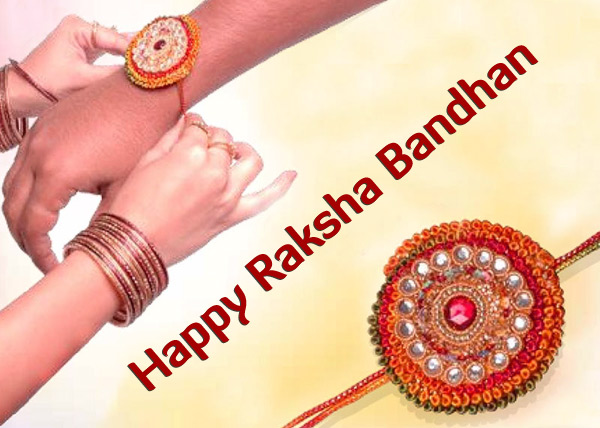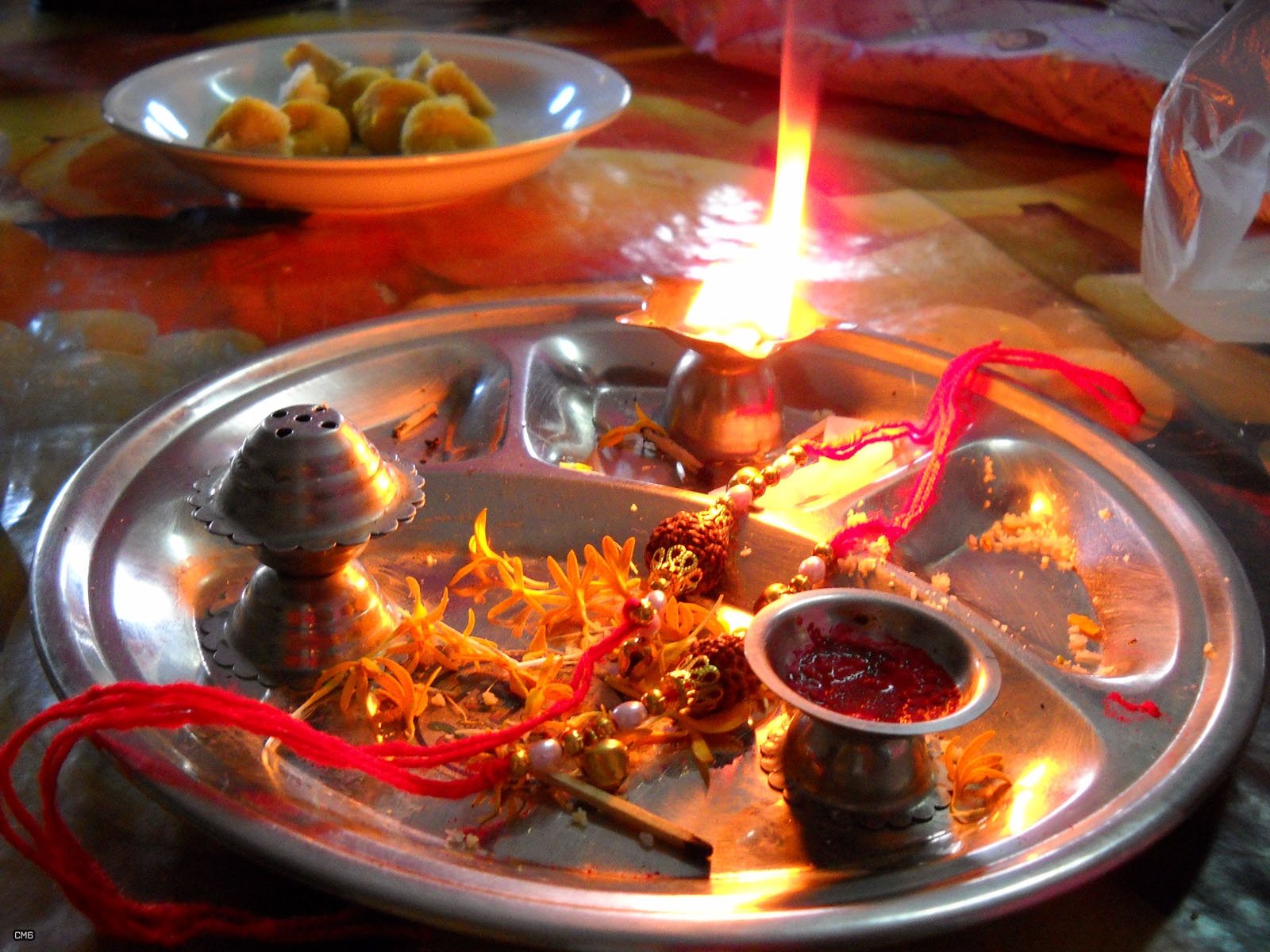Myths and parables :
The scriptures, epics of Hinduism is peppered with stories of Rakhi and Raksha Bandhan. Some of these include:
Indra Dev
According to Hindu scripture Bhavishya Purana, in the war between Gods and demons, Indra - the deity of sky, rains and thunderbolts - was disgraced by the powerful demon King Bali. Indra's wife Sachi consulted Vishnu, who gave her a bracelet made of cotton thread, calling it holy.[11] Sachi tied the holy thread around Indra wrist, blessed with her prayers for his well being and success. Indra successfully defeated the evil and recovered Amaravati. This story inspired the protective power of holy thread.[12][18][24] The story also suggests that the Raksha Bandhan thread in ancient India were amulets, used by women as prayers and to guard men going to war, and that these threads were not limited to sister-brother like relationships.
King Bali and Goddess Laxmi
According to this legend, credited to Hindu scriptures Bhagavata Purana and Vishnu Purana, after Vishnu won the three worlds from the demon King Bali, he was asked by Bali that Vishnu live in his palace, a request Vishnu granted. Vishnu's wife, Goddess Lakshmi did not like the palace or his new found friendship with Bali, and preferred that her husband and she return to Vaikuntha. So she went to Bali, tied a Rakhi and made him a brother. Bali asked her what gift she desired. Lakshmi asked that Vishnu be freed from the request that he live in Bali's palace. Bali consented, as well accepted her as his sister.
Santoshi Ma
Ganesh had two sons, Shubh and Labh. On Raksha Bandhan, Ganesh's sister visited and tied a Rakhi on Ganesh's wrist. The two boys become frustrated that they have no sister to celebrate Raksha Bandhan with. They ask their father Ganesh for a sister, but to no avail. Finally, saint Narada appears who persuades Ganesh that a daughter will enrich him as well as his sons. Ganesh agreed, and created a daughter named Santoshi Ma by divine flames that emerged from Ganesh's wives, Rddhi (Amazing) and Siddhi (Perfection). Thereafter, Shubh Labh (literally "Holy Profit") had a sister named Santoshi Ma (literally "Goddess of Satisfaction"), who loved and protected each other.
Krishna and Draupadi
Raksha Bandhan is celebrated in some Hindu, Jain and Sikh communities outside India. Above, Rakhi tied to a man's wrist in Mauritius.
Krishna considered Draupadi his sister. When Krishna cut his finger while beheading Shishupal, Draupadi immediately tore off a piece of her sari and bandaged his cut. Krishna said that with this loving act, she wrapped him in debt and he would repay each "thread" when the time arrives. Indeed, whenever Draupadi needed Krishna's protection she fervently prayed for his help, he came to the rescue and gave her unlimited cloth. This is one of the stories of the origin of the Raksha Bandhan festival.[citation needed]
In the epic Mahabharat, Draupadi tied a Rakhi to Krishna, while Kunti tied her Rakhi to her grandson Abhimanyu, before the great war.
Yama and the Yamuna
According to another legend, Yama, the god of Death had not visited his sister Yamuna for 12 years. Yamuna, the goddess of Yamuna river, was sad and consulted Ganga, the goddess of Ganga river. Ganga reminded Yama of his sister, upon which Yama visits her. Yamuna was overjoyed to see her brother, and prepared a bounty of food for Yama. The god Yama was delighted, and asked Yamuna what she wanted for gift. She wished that he, her brother should return and see her again soon. Yama was moved by his sister's love, agreed and to be able to see her again, made river Yamuna immortal. This legend is the basis for a Raksha Bandhan-like festival called Bhai Duj in some parts of India, which also celebrates brother-sister love, but near Diwali.
Historical references :
Rabindranath Tagore and Rakhi
Rabindranath Tagore, the Indian Nobel Laureate for literature, invoked Raksha Bandhan and Rakhi, as concepts to inspire love, respect and a vow of mutual protection between Hindus and Muslims during India's colonial era.[32] In 1905, the British empire divided Bengal, a province of British India on the basis of religion. Rabindra Nath Tagore arranged a ceremony to celebrate Raksha Bandhan to strengthen the bond of love and togetherness between Hindus and Muslims of Bengal, and urge them to together protest the British empire. He used the idea of Raksha Bandhan to spread the feeling of brotherhood. In 1911, British colonial empire reversed the partition and unified Bengal, a unification that was opposed by Muslims of Bengal. Ultimately, Tagore's Raksha Bandhan-based appeals were unsuccessful. Bengal not only was split during the colonial era, one part became modern Bangladesh and predominantly Muslim country, the other a largely Hindu Indian state of West Bengal. Rabindranath Tagore started Rakhi Mahotsavas as a symbol of Bengal unity, and as a larger community festival of harmony.In parts of West Bengal, his tradition continues as people tie Rakhis to their neighbors and close friends.[34]
One of Tagore's poem invoking Rakhi is:
Rakhi threads on sale in India.
The love in my body and heart
For the earth's shadow and light
Has stayed over years.
With its cares and its hope it has thrown
A language of its own
Into blue skies.
It lives in my joys and glooms
Multiculturalism :
In contemporary practice, Raksha Bandhan festival has developed into a broader context and a multicultural event.[43] Priests tie rakhis around the wrists of congregation members. Rakhis are often shared between close friends. Women tie rakhis around the wrists of the heads of state, political party or social leaders. Ceremonies are also held to tie Rakhi around the wrists of soldiers. Some Muslims in India view it a secular, multicultural festival.
In the spring night's buds and blooms
Like a Rakhi-band
On the Future's hand.
Edited by ipkkndkasr - 10 years ago








